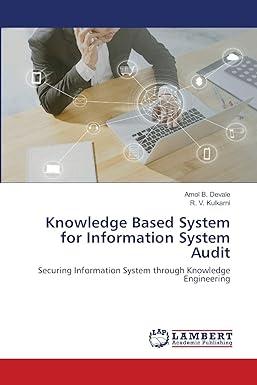Question
1. Stockholders' equity will be decreased by: a. purchasing land for cash. b. purchasing land on credit. c. borrowing funds from a bank. d. incurring
1. Stockholders' equity will be decreased by: a. purchasing land for cash. b. purchasing land on credit. c. borrowing funds from a bank. d. incurring interest expense on borrowed funds.
2. Immediately expensing the cost of a wastepaper basket with an estimated useful life of 20 years in the period when purchased is supported by which accounting principle? a. Consistency. b. Matching. c. Materiality. d. Going concern. e. None of these.
3. In a bank reconciliation, outstanding checks are: a. deducted from the book balance. b. added to the book balance c. deducted from the bank balance. d. added to the bank balance.
4. MW Co., a book store, purchased textbooks with a list price of $3,500 from a publisher. MW was offered credit terms of 2/15, net 20. If MW pays for the books 10 days after the purchase, MW will pay the publisher: a. 3,570 b. 3,500 c. 3,430 d. 3,395 e. None of the above is correct.
5. Last year the Grace Company had net sales of $900,000 and a gross profit of $380,000. Cost of goods available for sale totaled $1,010,000, and ending inventory was $490,000. If purchases for the year were $800,000, what was the amount of beginning inventory? a. $520,000 b. $280,000 c. $310,000 d. $210,000 e. None of these.
6. ABC company received goods costing $67,000 on January 5, 20X4 that was shipped FOB shipping destination on December 29, 20X3. The shipment was a rush order that was arrived January 5, 20X4. The above $67,000 merchandise in transit: a. Should not be included in the Dec. 31, 20X3 ending inventory. b. Should be included in the Dec. 31, 20X3 ending inventory. c. both including or not including in the ending inventory is correct. d. none of the above is correct.
7. The failure to record an accrued revenue will have what effects on the following classifications?
Revenue Assets Liabilities a. Understate Understate None b. Understate None Understate c. Overstate Overstate None d. Overstate None Overstate
8. Which one of the following accounts will not have a zero balance after all closing entries have been made at year end? a. Wages expense b. Service revenue c. Insurance expense d. Accumulated depreciation.
9. The beginning inventory for a merchandising firm was $68,000 and the ending inventory is $62,000. If the net cost of purchases was $90,000 and net sales were $160,000, The gross profit was: a. $84,000 b. $64,000 c. $70,000 d. None of the above.
10. The ABC Company paid cash for prepaid insurance. As a result of this accounting event: a. total assets were unaffected. b. total equity increased. c. total liabilities decrease. d. none of the above.
11. For Hallie's Pie Company you have the following data. Income Statement Item Amount Sales (all on credit) $250,000 Cost of Goods Sold (110,000) Gross Profit 140,000 Income from operations 44,000 Interest expense (14,000) Income before taxes 30,000 Income tax expense (12,000) Net income 18,000 Balance Sheet Item Beginning Ending Accounts receivable $17,400 $ 22,600 Inventory 11,300 12,700 Total assets 99,000 121,000 Total equities 63,000 71,000 Hallie's Inventory turnover ratio was: a. 9.73. b. 8.66. c. 9.16. d. 1.5. e. None of the above is correct.
12. An employee who had performed services for Ajax Company during the year had not been paid by December 31. The adjusting entry which Ajax Company must make before it prepares its financial statements for the year ended December 31 involves: a. A credit to a liability account. b. A debit to a liability account. c. A credit to an asset account. d. A debit to an asset account. e. No entry is required until the employee is paid.
13. Which of the following accounts would NOT appear in the post-closing trial balance? a. Unearned Rent Revenue b. Dividends c. Supplies d. Salaries Payable
14. When preparing a bank reconciliation, deposits in transit are: a. added to the balance per bank statement. b. subtracted from the balance per bank statement. c. added to the balance per company records. d. subtracted from the balance per company records.
15. Goods available for sale is equal to: a. ending inventory plus beginning inventory. b. beginning inventory, plus net purchases, minus ending inventory. c. net purchases plus beginning inventory. d. costs of goods sold minus beginning inventory.
16. Leigh Sawyer, an attorney, does not include her personal stock investments on the balance sheet for her law practice. This is an example of the basic principle of a. Accounting period. b. Full disclosure. c. Conservatism. d. Accounting entity. e. None of these.
17. Peter Paint Company sold $260 of custom wallpaper to Bruno Builder on March 7, 19XX, with the terms 3/15, n/30. If Bruno Builder remits payment on March 19, 19XX, then Peter Paint Company will record (assuming gross method is used): a. a credit to Sales Discounts for $7.80. b. a credit to Accounts Receivable for $252.20. c. a debit to Cash for $252.20. d. a debit to Accounts Receivable for $260.00.
Step by Step Solution
There are 3 Steps involved in it
Step: 1

Get Instant Access to Expert-Tailored Solutions
See step-by-step solutions with expert insights and AI powered tools for academic success
Step: 2

Step: 3

Ace Your Homework with AI
Get the answers you need in no time with our AI-driven, step-by-step assistance
Get Started


